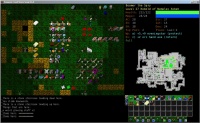Stash
Technically, a stash is any item which has been left on the Dungeon floor. In more common usage, however, a stash is a location in which a player dumps any items they do not wish to carry around at all times, but which may be useful later. Although there are arguments both for and against creating a massive, centralized stash for all your loot, all players will at some point or other need to drop items to open inventory space.
Contents
Strategy
The only true threat is jellies, which will eat anything they come across, so you can typically put your stash on any cleared level unlikely to generate them.
It's very easy to forget where you left a particular item as you explore. Fortunately, pressing "CTRL+f" brings up a search prompt which allows you to pinpoint where you left your things quickly and easily. This can be used to search for individual items (e.g. bread ration, +1 helmet), item categories (body armour, Maces & Flails, wand), spells (this will bring up all spell books which contain the spell), and even particular resistances or intrinsics.
Some players choose to create a single stash for all of their loot in branches which guarantee their safety. Common stash branches include:
- Not Dungeon:5-15 or the Slime Pits
- These are the floors on which jellies can randomly generate
- Lair:2
- Found roughly halfway through the Dungeon, making it a common area to walk past while exploring the various branches. Lair:1 can extremely rarely generate jellies.
- The Vestibule of Hell
- Multiple entrances found throughout the late game make it quickly accessible, especially if an entrance occurs on Lair:8.
There are arguments for and against making centralized stash locations, however.
Pros
- Tracking Inventory - Keeping all of your consumables in one place allows you to easily take stock of what you have and what you're lacking. Also, poring over your inventory may remind you that you have resources you'd forgotten about, and which would have otherwise gone to waste.
- Spell Decisions - Placing all your books in one pile allows you to see all spells currently available to you. While experienced players will often know exactly which spells they intend to use, others may benefit from seeing all their options at once and determining how best to use their available spell levels.
- Convenience - Rather than manually typing in an item name each time you need to find one, you can simply autotravel to the branch where you left all your stuff.
- Safety - It may be paranoia, but no one likes discovering that their last potion of cure mutation is now jelly food.
Cons
- Unnecessary - It is perfectly reasonable to drop items wherever you want and to expect them to be there when you get back.
- Wasteful - If you leave items which are commonly used lying in multiple locations throughout the Dungeon, you'll spend less time reaching them and returning to the area you were exploring than if you haul them all back up a dozen Dungeon floors for deposit. This conserves your food and reduces your turn count.
History
Prior to 0.15, items could be destroyed through item destruction, forcing the player to risk losing items in the inventory or leave them behind. Also, items had weight and would eventually be too much of a burden for your character to carry. These facts greatly influenced how players chose what to stash and what to carry. Also, all teleport traps were permanent, and characters with stasis could use them as untouchable stash sites.
